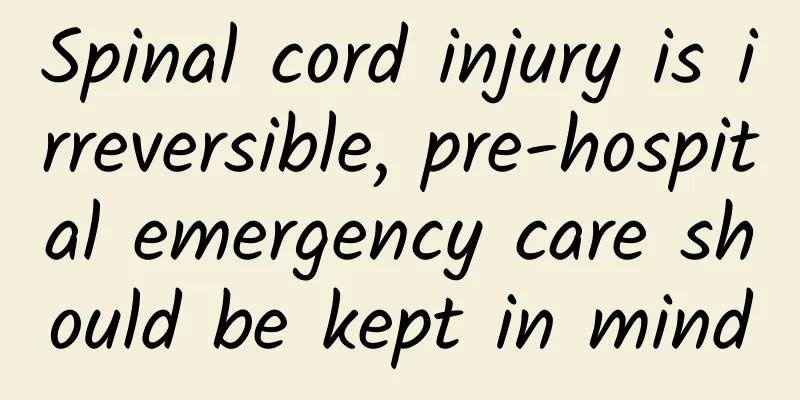Spinal cord injury is irreversible, pre-hospital emergency care should be kept in mind

|
Spinal cord injury (SCI) refers to damage to the neural structures in the spinal canal (including the spinal cord, nerve roots, and cauda equina) due to various reasons, and the occurrence of sensory, motor, reflex, and urinary and bowel dysfunction at or below the level of injury. Spinal cord injury is a serious trauma with high disability, and with the increasing incidence of traffic accidents and construction accidents . In recent years, the number of SCI patients worldwide has reached 27.04 million, of which the total number of SCI patients in the United States is 250,000 to 368,000 , while the number of SCI patients in China has exceeded 1 million. The incidence of spinal injuries has gradually increased worldwide . Due to the severity and complexity of spinal injuries, effective pre-hospital first aid can ensure the patient's life safety, protect the patient's residual spinal cord function, avoid delaying the optimal treatment time, and lay a good foundation for subsequent treatment . In 1992, the American Spinal Injury Association (ASIA) first developed a classification standard for neurological function in spinal cord injury. In 2000, this standard was revised based on clinical application, which is now the widely used classification standard for spinal cord injury internationally. 0 1 Classification of Spinal Cord Injuries Spinal cord injury is divided into complete spinal cord injury and incomplete spinal cord injury. 1. Complete spinal cord injury means that the patient may retain some sensory or motor functions below the injury level. These segments are the corresponding sensory or motor function partial preservation zones (ZPP). 2. Incomplete spinal cord injury has some special manifestations, including the following common clinical syndromes: 1) Hemicord syndrome 2) Central cord syndrome 3) Anterior spinal cord syndrome 4) Posterior spinal cord syndrome 5) Conus medullaris syndrome 6) Cauda equina syndrome 7) Spinal cord concussion 0 2 If a patient has an accident and it is considered that there may be a spinal cord injury, how should we deal with it? What precautions should be taken at the scene? The principle of clinical treatment of spinal cord injury is to save the patient's life, prevent and treat complications , so as to apply various methods (medical, engineering, educational) to maximize the use of all remaining functions (including autonomous functions and reflex functions) and enable the patient to resume independent living and return to society in the shortest possible time, that is, full recovery. 0 3 Significance of first aid treatment after spinal cord injury The treatment in the first aid stage is crucial for patients with spinal cord injury . First of all, whether the first aid measures are correct and timely affects the patient's prognosis ; secondly, surgery or other diagnostic and treatment methods. Patients with incomplete spinal cord injury may become complete spinal cord injury due to improper first aid treatment, and lose the possibility of spinal cord function recovery; patients with complete spinal cord injury may cause the spinal cord injury level to rise due to improper first aid treatment. This means that the patient's rehabilitation goal is significantly reduced and the degree of disability is significantly aggravated . 0 4 Importance of pre-hospital emergency care Pre-hospital emergency care is the diagnosis and treatment of patients at the scene of injury and during the process of transfer to the hospital from the time of injury to the time of admission. Pre-hospital emergency care is the key stage of spinal cord injury emergency care. Among the patients with spinal cord injury who died in the first year after injury, 90% died during the on-site transfer, and 23-26% of the patients had significantly worsened spinal cord injuries during pre-hospital emergency care. Therefore, it is particularly important to strengthen the education and publicity of pre-hospital emergency care and the training of grassroots personnel . 0 5 Post-injury treatment First, determine whether the patient has spinal cord injury and fatal combined injuries . If the patient's cardiopulmonary function is good and vital signs are stable, further examination can be performed to determine whether there is spinal cord injury. During the examination, the spine should be kept stable and the patient should be moved as little as possible. Patients with spinal injuries should be immediately immobilized if spinal cord injury is suspected , and if the patient is in danger of life, they should be immediately moved out of the scene. There are two options for immobilization positions. One is to maintain the position after injury to avoid further injury to the spinal cord during movement; the other is neutral position immobilization, that is, supine position immobilization, which is a traditional immobilization method. When changing to the neutral position, the patient should be observed for pain or worsening nerve damage, and the position should not be changed forcibly. Immobilization equipment can be used if conditions permit, and a spinal fixation board or collar can be used. In the absence of immobilization, the correct transportation method should be adopted to keep the spine stable. How to carry a patient with spinal cord injury by three people How 4 people work together to carry a patient with spinal cord injury Things to note during transportation After the patient is initially diagnosed with possible spinal cord injury, the last step of out-of-hospital emergency treatment is to transfer the patient to a hospital after reliable immobilization and removal from the scene. The nearest hospital that can handle spinal cord injuries should be selected, and routine transfer to other hospitals should not be done step by step to avoid wasting time and delaying treatment. Tips for good luck Spinal cord injury is irreversible, pre-hospital emergency care should be kept in mind Saving lives is the first priority, and emergency treatment should be given attention Dragging or holding is not feasible, the head, neck and torso need to be fixed Protective braking is the most critical, every second counts to save lives END Author: Wei Meng, Liu Wenlan, Gao Caiping Shanghai Tongji University Affiliated Yangzhi Rehabilitation Hospital (Shanghai Sunshine Rehabilitation Center) Chief Judge: Zhai Hua, Yangzhi Rehabilitation Hospital Affiliated to Tongji University, Shanghai, Vice Chairman of the Science Popularization Working Committee of the Chinese Rehabilitation Medicine Association Editor: Jia Jing, Illustration: Li Chuan (Xinhua Hospital Affiliated to Shanghai Jiao Tong University School of Medicine) |
<<: Spring is here, is allergic rhinitis far behind?
Recommend
Vulvar leukoplakia cancer
Vulvar leukoplakia is diffuse white patches that ...
What is the cause of yellow sticky discharge?
Female friends should have a comprehensive and cl...
What are the methods for reversing atherosclerotic plaques? What drugs can be chosen?
Atherosclerotic plaques are a concern for many fr...
What to do if you don't have your period after 50
After menopause, women will have more and more wr...
How to manage a relationship? How do newlyweds maintain their relationship?
Nowadays, the pace of life is getting faster and ...
Can you have sex during menstruation? It is so harmful.
You cannot have sex during menstruation because w...
What to do if menstruation does not come out
Every woman is particularly concerned about menst...
Optimal treatment for patients with acute cerebral infarction
Acute cerebral infarction is an emergency situati...
Lumbar muscle strain after confinement
Some women suffer from various diseases after giv...
I used to have breast pain before period and now my nipples hurt. Why?
When women have their period, the hormones in the...
Frequent blinking? Be careful, it may be this eye disease...
Many organs in the human body have the ability to...
Too long eyelashes can damage your eyes
When praising someone for their beauty, people al...
What should I do if I have the new coronavirus on my skin?
This is the 4190th article of Da Yi Xiao Hu The c...
Can my aunt eat hot pot?
In Chongqing, spicy food is the main dish. Chongq...









